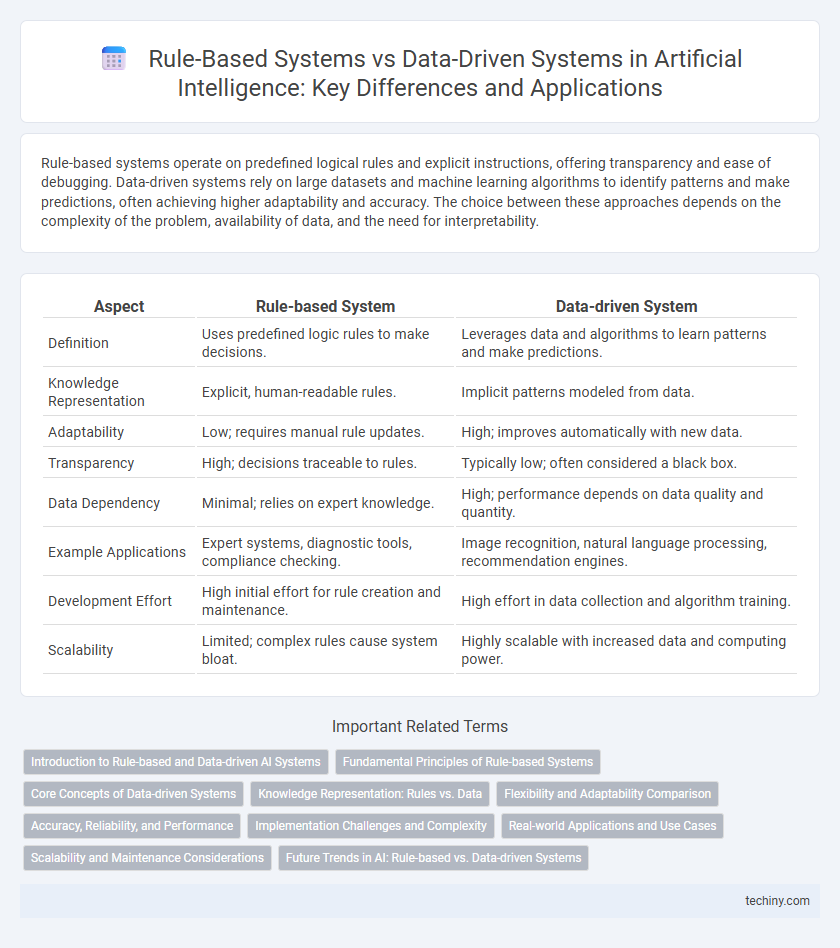Rule-based systems operate on predefined logical rules and explicit instructions, offering transparency and ease of debugging. Data-driven systems rely on large datasets and machine learning algorithms to identify patterns and make predictions, often achieving higher adaptability and accuracy. The choice between these approaches depends on the complexity of the problem, availability of data, and the need for interpretability.
Table of Comparison
| Aspect | Rule-based System | Data-driven System |
|---|---|---|
| Definition | Uses predefined logic rules to make decisions. | Leverages data and algorithms to learn patterns and make predictions. |
| Knowledge Representation | Explicit, human-readable rules. | Implicit patterns modeled from data. |
| Adaptability | Low; requires manual rule updates. | High; improves automatically with new data. |
| Transparency | High; decisions traceable to rules. | Typically low; often considered a black box. |
| Data Dependency | Minimal; relies on expert knowledge. | High; performance depends on data quality and quantity. |
| Example Applications | Expert systems, diagnostic tools, compliance checking. | Image recognition, natural language processing, recommendation engines. |
| Development Effort | High initial effort for rule creation and maintenance. | High effort in data collection and algorithm training. |
| Scalability | Limited; complex rules cause system bloat. | Highly scalable with increased data and computing power. |
Introduction to Rule-based and Data-driven AI Systems
Rule-based AI systems operate using predefined sets of explicit rules curated by human experts, enabling precise control and interpretability in decision-making processes. Data-driven AI systems leverage large datasets and machine learning algorithms to identify patterns and generate predictions, allowing adaptability and scalability in complex environments. Combining both approaches enhances AI performance by integrating human knowledge with automated learning.
Fundamental Principles of Rule-based Systems
Rule-based systems operate on a foundation of explicitly defined if-then rules derived from human expertise, enabling deterministic decision-making processes. These systems rely on symbolic reasoning and logical inference engines to interpret and apply rules to specific data inputs. Their transparency and predictability make them suitable for applications requiring clear explanation and validation of AI-driven conclusions.
Core Concepts of Data-driven Systems
Data-driven systems rely on large volumes of data and machine learning algorithms to identify patterns and make predictions, enabling adaptive and scalable solutions. These systems prioritize empirical evidence and statistical models over predefined rules, thus improving performance with diverse and evolving datasets. Core concepts include feature extraction, model training, validation, and continuous learning from new data inputs.
Knowledge Representation: Rules vs. Data
Rule-based systems rely on explicitly encoded knowledge through if-then rules, enabling transparent decision-making processes and easy debugging. Data-driven systems use large datasets and machine learning algorithms to implicitly capture knowledge patterns, allowing adaptability and improved performance with more data. Knowledge representation in rule-based systems centers on symbolic logic, while data-driven systems emphasize statistical models and feature extraction.
Flexibility and Adaptability Comparison
Rule-based systems rely on predefined logic and are less flexible in handling unforeseen scenarios, limiting adaptability to dynamic environments. Data-driven systems leverage machine learning algorithms to continuously improve from new data, offering higher flexibility and adaptability for evolving tasks. This adaptability enables data-driven approaches to outperform rule-based methods in complex and changing AI applications.
Accuracy, Reliability, and Performance
Rule-based systems in artificial intelligence offer high reliability due to their explicit logic and deterministic nature but may lack accuracy in complex or ambiguous scenarios. Data-driven systems leverage machine learning models to improve accuracy by learning from vast datasets, yet their reliability can vary depending on data quality and model robustness. Performance-wise, rule-based systems provide faster inference times in well-defined tasks, while data-driven systems often require more computational resources but excel in adapting to diverse and evolving inputs.
Implementation Challenges and Complexity
Rule-based systems require extensive manual coding of explicit rules, making implementation complex and time-consuming, especially for domains with vast or ambiguous knowledge bases. Data-driven systems rely on large datasets and advanced machine learning algorithms, which introduce challenges related to data quality, algorithm selection, and computational resource demands. Both approaches face scalability issues, but data-driven methods often require more sophisticated infrastructure for training and continuous updating.
Real-world Applications and Use Cases
Rule-based systems excel in domains with well-defined, explicit rules such as expert systems for medical diagnosis and fraud detection in finance. Data-driven systems leverage machine learning to analyze large datasets, powering applications like image recognition in autonomous vehicles and natural language processing in virtual assistants. Hybrid approaches combine rule-based logic with data-driven models to enhance decision-making in complex environments like cybersecurity and personalized marketing.
Scalability and Maintenance Considerations
Rule-based systems face scalability challenges due to the exponential increase in rules required to cover complex scenarios, making maintenance labor-intensive and prone to errors. Data-driven systems leverage machine learning algorithms that automatically improve with more data, enhancing scalability and simplifying maintenance through continuous model updates. This adaptability allows data-driven approaches to better handle evolving environments and reduce the need for manual intervention.
Future Trends in AI: Rule-based vs. Data-driven Systems
Future trends in AI indicate a growing shift towards data-driven systems due to their ability to learn and adapt from large datasets, enhancing accuracy and scalability in complex tasks. However, rule-based systems maintain significance in scenarios requiring transparency, interpretability, and strict compliance, especially in regulated industries. Hybrid approaches combining rule-based logic with data-driven learning models are emerging, offering optimized performance by leveraging the strengths of both methodologies.
Rule-based System vs Data-driven System Infographic

 techiny.com
techiny.com